Abstract
This research is important to assist the Philippines develop more effective community engagement adaptation approaches and policies to better respond locally to climate change and disaster risk management. To explore this, a literature review was undertaken followed by interviews and focus group discussions with local experts and community representatives. Findings from the literature review were that strong (active and inclusive) community engagement approaches to climate change and disaster risk management were more effective than weak (passive and consultative) approaches. These results were compared to fieldwork interviews and focus group discussions in two typhoon-prone Philippine provinces. Findings revealed that while strong and weak community engagement approaches exist in the Philippines, respondents at provincial and local levels supported the development of strong community engagement that involved capacity building and open information and dialogue. Meaningful engagement with stakeholders and across sectors that embraced Filipino community engagement customs and characteristics were emphasised.
Introduction
This paper presents findings from a larger study on investigating effective community engagement approaches in relation to climate change adaptation (CCA) and disaster risk reduction and management (DRRM) for coastal communities in the Philippines. Here, effective involves participatory, timely, jurisdictionally coherent, government and community action plans (Yoseph- Paulus & Hindmarsh 2018).
There is an increasing understanding in the Philippines of the interrelationship between CCA and DRRM, the latter including emergency response and management (Fernandez et al. 2012, Republic of the Philippines 2010). This understanding reflects international trends of integrating CCA with DRRM (e.g. Mitchell & van Aalst 2008, UNISDR 2015). The Philippines is vulnerable to weather-related disasters like storm surges, tsunamis and flooding (Needham 2015). Poverty and inadequate social, technological and financial capacities contribute to this vulnerability (UNFCCC 2007, World Bank 2013). Most of the population lives in coastal communities and they depend on coastal resources for food and their livelihoods. These communities are the most vulnerable to flooding and coastal erosion.
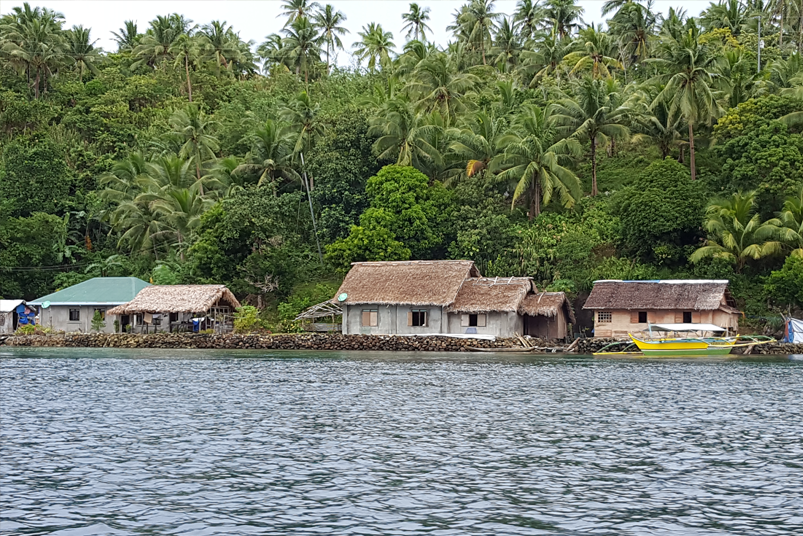
Fishing is one of the primary sources of livelihood for coastal and island communities. Images: Carla Baybay
Community interactions that occur during weather-related disasters have always existed in the Philippines using traditional community-based activities informed by local knowledge (Bankoff 2012). In 1978, community disaster reduction and management was institutionally recognised through the Community Disaster Preparedness Program under Presidential Decree No. 1566. However, a top-down, reactive approach to disaster management prevailed, despite the community-based approaches (Fernandez et al. 2012, Heijmans & Victoria 2001). In 1984, community-based disaster management was pioneered and promoted in the non-government sector through the Citizens’ Disaster Response Network (Bankoff 2012, Heijmans & Victoria 2001).
Given current climate change affecting the Philippines, it lacks effective CCA and DRRM policies for coastal communities. Ancheta and colleagues (2010) indicate that continuing reactive and ineffective policy styles of community engagement for CCA and DRRM needs to change to proactive community-based approaches. Proactive responses complement the development and implementation of CCA and DRRM in the Philippines. The first is the Climate Change Act of 2009 and Disaster Risk Reduction and Management Act of 2010; both mention community engagement as essential (Republic of the Philippines 2009, 2010). The second is the 2011–2028 Philippine National Disaster Risk Reduction and Management Plan that strengthens CCA and DRRM capacities (nationally and locally) through good governance principles (NDRRMC 2011, also CEC 2001). For example, principles of transparency, enhanced participation and policy coherency are applicable to contemporary international community engagement. When applied, they could help redress weaknesses in current Philippine CCA and DRRM community engagement related to fragmented and uncoordinated government planning with inadequate capacity to meaningfully engage coastal communities (Ancheta et al. 2010, World Bank 2013).
This paper reviews the international literature on community engagement approaches to CCA and DRRM in developing and developed countries. It describes methods and results of interviews and focus group fieldwork on the effectiveness of existing local community engagement approaches for CCA and DRRM with local experts and communities in the Philippine coastal zone. It also compares the literature review and fieldwork findings to recommend effective CCA and DRRM forms of community engagement.
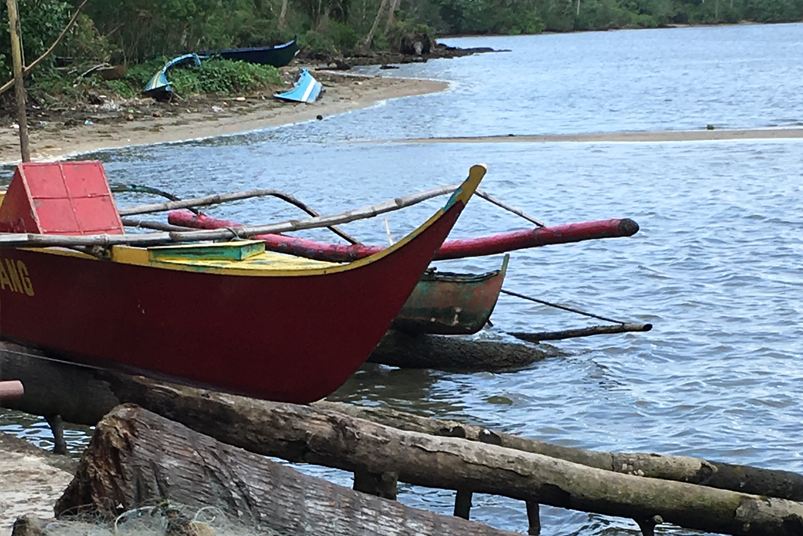
Fishing is one of the primary sources of livelihood for coastal and island communities. Images: Carla Baybay
Literature review
Community engagement is frequently considered as the mutual interaction between government and community members to increase information and community input for policy formulation; in turn, to support government services to facilitate consensual government and community goals (Cavaye 2004, Meikle & Jones 2013). Community engagement can range from ‘weak’ to ‘strong’ as shown in the public participation spectrum of the International Association for Public Participation (IAP2) (IAP2 2007, Hindmarsh 2012, Nkoana et al. 2017). Weak forms comprise information dissemination and consultation while stronger forms include active and inclusive engagement (Cavaye 2004, Quick & Feldman 2011). The latter is a collaborative partnership approach and is more meaningful (and effective) for both communities and policy development. Strong engagement increases the legitimacy of government actions through the generation and sharing of diverse ideas and knowledge that provides for equitable and effective decision-making (Benham 2017, Cavaye 2004).
Strong community engagement provides the best opportunity for including local community knowledge, perspectives of place and local values and attitudes in decision-making processes. This produces more effective policy outcomes that engenders local support, ownership and substance (Cavaye 2004, Devine-Wright 2005, Hindmarsh 2010, Nkoana et al. 2017, Samaddar et al. 2015). Important elements include early involvement in planning and implementation, integration of stakeholder knowledge, openness and transparency of information, dialogue and partnerships with government, business and non-government organisations (Gero et al. 2010, Hindmarsh 2012, Quick & Feldman 2011).
Conversely, weak (or less inclusive) community engagement approaches focus on disseminating top-down information and gathering feedback on government proposals or issues through consultation via town hall meetings, surveys and committees. They tend to reflect normal business over time and lack willingness or knowledge to develop stronger approaches (Aldunce et al. 2016, Cavaye 2004, Hindmarsh 2012, Nkoana et al. 2017). Typically, they feature fragmented planning and policy processes that result in poor coordination and policy implementation. They perpetuate cultural barriers to participation involving cultural leadership, beliefs and perspectives; community marginalisation and lack of supportive resources (McMartin et al. 2018, Samaddar et al. 2015, Zafrin et al. 2014). The burgeoning international literature supports the view that strong community engagement is highly effective to address the interrelated social and environmental complexities of CCA and DRRM (e.g. Schlosberg et al. 2017, Tanwattana 2018).
Methods
Fieldwork investigation involved local experts and community representatives in four coastal communities of Sorsogon City (Sorsogon Province) and five coastal communities in the Municipality of Lavezares (Northern Samar Province). Both provinces are situated in typhoonprone areas in the eastern seaboard of the Philippines (Figure 1).
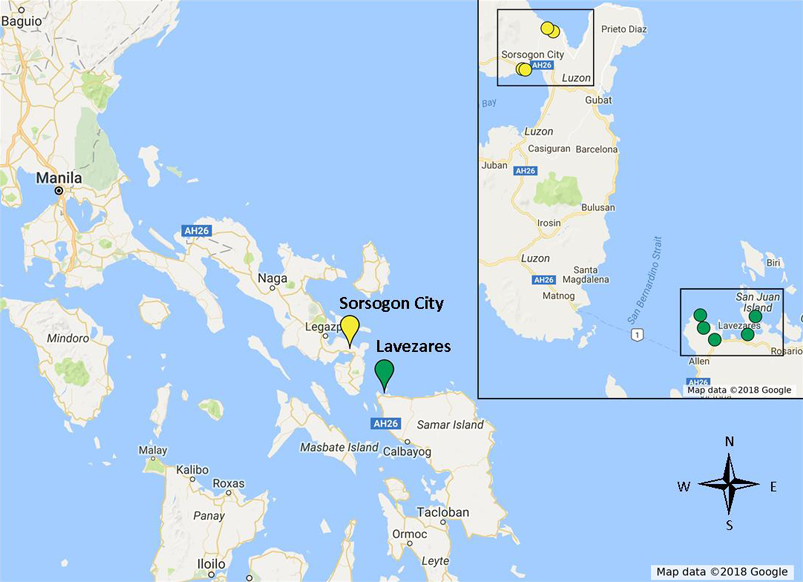
Figure 1: Fieldwork sites of Sorsogon and Northern Samar provinces.
The selection of these two neighbouring provinces as fieldwork sites was based on:
- both provinces being identified at ‘very high risk’ or ‘high risk’ to climate change and weather-related hazards (World Bank 2013)
- both provinces having existing community-based approaches to CCA and DRRM
- the recommendations of key local government officials regarding community attendance to, and participation in, local CCA and DRRM activities, including developing plans and the quality of community leadership.
These recommendations were made by local government officials in a preliminary meeting prior to the interviews and focus group discussions to identify which communities would best fit the research aims. Data were collected from local experts and community representatives on their views of effective and ineffective approaches to CCA and DRRM. The research was undertaken between October and November 2017 in two stages:
- Twenty-four face-to-face semi-structured interviews were conducted with local experts (11 in Sorsogon City and 13 in Lavezares) from relevant local government agencies, non-government organisations, community and other organisations (including fisherfolk, farmers and women’s organisations) and community councils.
- Twelve focus group discussions were held with coastal community representatives from community councils, volunteer groups, CCA and DRRM groups and emergency response teams. This involved seven focus groups in Sorsogon City (44 participants) and five focus groups in Lavezares (53 participants).
All respondents were involved in a range of CCA and DRRM activities such as planning, implementation and evaluating plans, projects, programs, policies and activities at provincial, city, municipal and community levels. The interviews were conducted in English or Filipino or both, depending on the preference of the respondent, while the focus group discussions were conducted in Filipino. The data were translated to English during transcription. To prevent loss of meaning in translation, key words or phrases from the responses that were considered important were retained in Filipino (cf. Vallance & Lee 2005). Footnotes were added to explain the context of these responses alongside the closest interpretation of the key words or phrases based on Philippine literature (i.e. bayanihan). The interview and focus group records were listened to a second time to ensure that nothing was missed in the transcription and translation processes.
NVivo software was used to organise concept-driven codes derived from the research questions, conceptual framework and fieldwork questionnaire. Data-driven codes were generated through repeated reading of transcripts and were organised into themes and subthemes by identifying patterns and distinct features from data that addressed the research aim.
The results represent the structure of the interview and focus groups. Respondents were asked to contribute to the following themes:
- current community engagement approaches
- challenges to achieve effective community engagement
- recommendations for effective community engagement.
The responses were organised by theme and by data type (local expert interview respondents and focus group community representatives together, when or where occurring).
Results
Theme 1: Current community engagement approaches
According to city and municipal officials and community representatives in each province, coastal community engagement comprised ‘participatory processes’ and ‘multi-sectoral approaches’. This supported existing CCA and DRRM plans in Sorsogon City and Lavezares and included dialogue, public consultations, meetings, seminars, community assemblies, volunteer groups and emergency response teams. Engagement activities focused on capacity building, research and planning, community-based environmental activities, infrastructure improvements, information dissemination and CCA and DRRM policy implementation through government and non-government programs and projects.
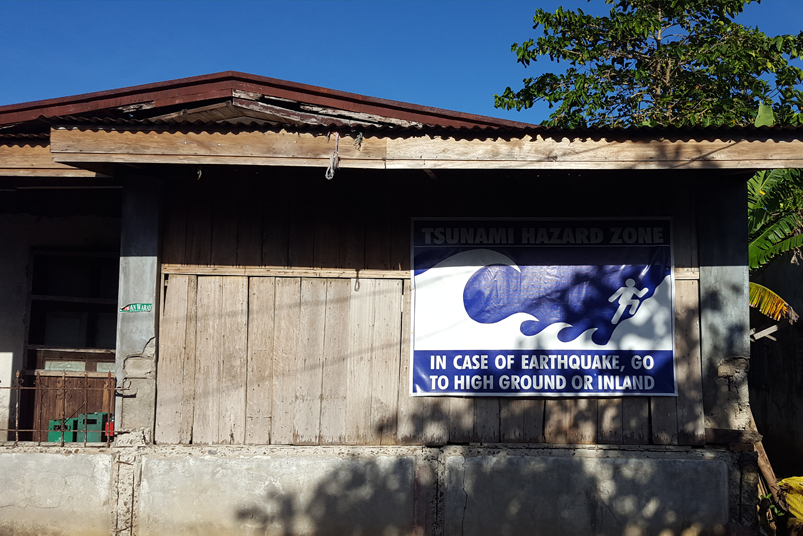
Information about tsunami warnings is placed in obvious places within the community. Image: Carla Baybay
Theme 2: Challenges to achieve effective community engagement
Three sub-themes emerged from the data.
Weak engagement with community: Sorsogon City local expert respondents indicated that communities had poor commitment to engagement and this added to their distrust of community officials. Respondents from both provinces indicated there was poor community attendance and participation in CCA and DRRM activities due to priorities of daily life and livelihoods or un-cooperativeness. Community representatives from both provinces reported that uncooperative communities held negative attitudes about participation because they were not informed about CCA and DRRM issues nor how to participate. In addition, local people held particular political preferences about the person implementing the program and this could affect their participation.
Limited decision-making: several local expert respondents from both provinces, as well as community representatives, regarded CCA and DRRM engagement practices as limited because they involved top-down implementation of plans and dissemination of information to communities and submission of required local government and community reports related to CCA and DRRM projects and activities (especially in Lavezares). Similarly, decision-making for community programs and projects was left to city and municipality officials and staff, often with no community validation occurring through adequate community consultation and information sharing.
Underdeveloped policy: local expert respondents and community representatives from both provinces raised several sub-themes. These were lack of political will; limited budgets; limited infrastructure for CCA and DRRM preparedness; insufficient CCA policy knowledge, implementation and evaluation as well as inadequate integration of CCA and DRRM policies exacerbated by a lack of coordination among government agencies. Of the two provinces, Lavezares experienced these situations the most.
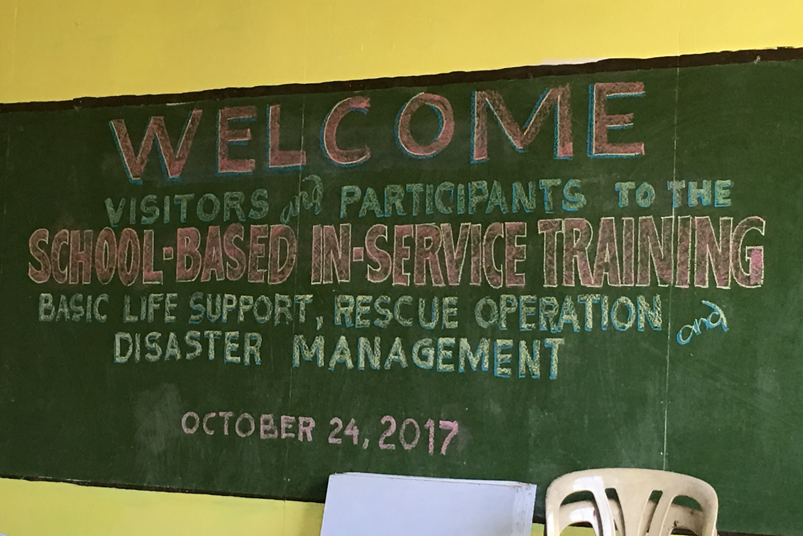
One of several DRRM capacity building trainings that local government conducts for local communities and other sectors. Image: Carla Baybay
Theme 3: Recommendations for effective community engagement
Three subthemes emerged from the research.
Improving community activities, knowledge, skills and resources: local expert respondents recommended increased CCA and DRRM budgets for this area. In contrast, community representatives recommended empowering community officials and fostering better stakeholder and sector partnerships as part of stronger community planning and capacity building. As one local interview respondent emphasised, ‘all communities becoming resilient, safe, secure and adaptive’.
Stronger community engagement through adoption of local culture and practice: local expert respondents and community representatives from both provinces recommended that Filipino characteristics of unity, solidarity, helpfulness, industriousness and resilience practiced in communities could be incorporated into community engagement activities. Additionally, that the Filipino custom of bayanihan be adopted in its traditional representation as a voluntary community effort to achieve unity, cooperation, solidarity and generosity.
Strong policy development: local expert respondents and community representatives from both provinces recommended stronger policy and community engagement particularly regarding government leadership and support. As one community representative expressed, ‘if there is … effective leadership, then there is effective governance’. Strong policy relied on knowledge integration, particularly information and open dialogue between governments and with communities. This would lead to improved community awareness of CCA and DRRM policies, alongside better policy implementation. As such, more meaningful and better resourced community engagement would deliver integrated local CCA and DRRM plans and policies. Another recommendation was to modify several overly technical approaches and language in policies that diluted the social context and was hard to understand and relate to by community members.
Discussion
This research considered aspects of effective community engagement to increase the CCA and DRRM capacity and resilience of two coastal communities in the Philippines. Local experts and community representatives indicated preferences for strong community engagement approaches for CCA and DRRM; supporting the international literature.
Existing community engagement is weak and ineffective particularly in areas of CCA and DRRM. Features of weak community engagement included insufficient information for community awareness, community non-participation, limited top-down decision-making, lack of community inclusion and program validation and underdeveloped policy in areas of planning, budgets and engagement (McMartin et al. 2018, Samaddar et al. 2015, Zafrin et al. 2014). Also criticised were the fragmented and uncoordinated government practices (see also Yoseph-Paulus & Hindmarsh 2018) as well as ineffective policy implementation and integration of CCA and DRRM policies.
Although Lavezares was the weaker in these areas, Sorsogon City also experienced many challenges to effective community engagement, specifically, underdeveloped policy and the lack of political will to prioritise CCA and DRRM at government and community levels. Weak and reactive approaches to CCA and DRRM were prevalent in Lavezares and that impeded the community from adopting more proactive responses.
Many recommendations were made by the local expert respondents and community representatives that align to strong community engagement. These included improving community activities, knowledge, skills and resources as well as better government leadership and support (see also Benham 2017, Cavaye 2004, Gero et al. 2010, Hindmarsh 2012, Quick & Feldman 2011) and adoption of local culture and practices (Kanakis & McShane 2016, Mercer et al. 2009) underpinned by strong policy development. Of importance was adopting the Filipino custom of bayanihan, which stresses collective action within communities (Labonne & Chase 2011).
To deliver strong policy development, areas explored were stronger government leadership and support, knowledge integration between government and communities, improved community awareness, better policy implementation and enhanced community engagement to develop plans with emphasis on social context and everyday language. These recommendations indicated the active role local communities seek to (and should) have in CCA and DRRM.
Conclusion
This evidence supports the development and integration of strong community engagement approaches for CCA and DRRM in the Philippines that would also embrace the good governance principles of the Philippine National Disaster Risk Reduction and Management Plan. Of importance are capacity building, open information and dialogue mechanisms and meaningful partnerships with stakeholders. This would involve inclusion of community knowledge and perspectives as well as traditional Philippine community engagement customs and characteristics.


